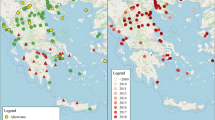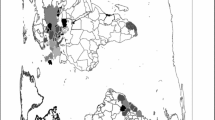Abstract
Harmonia axyridis (Pallas) (Coleoptera: Coccinellidae) is native to Asia, and was widely introduced as a biocontrol agent of aphids and coccids in Europe and North America. In Europe H. axyridis is considered to be an invasive alien species. Although not known to have been deliberately introduced to Great Britain, it was first recorded there in 2004, in south-east England. Harmonia axyridis arrived in Great Britain by various means, primarily from mainland Europe, but also from Canada. Extensive national and local media coverage, and a dedicated website (http://www.harlequin-survey.org), facilitated public involvement in recording H. axyridis in Great Britain; in excess of 4,000 verified records of the species were received between 2004 and 2006. Through detailed mapping, the objective of our study was to quantify and analyse the spread of H. axyridis in its early stages of invasion in Great Britain. Our data shows that between 2004 and 2006, the species spread north through Great Britain at the rate of 58 km year-1 and west at the rate of 144.5 km year-1. In England H. axyridis spread north to Yorkshire and west to Cornwall by the end of 2006, and also reached Wales. Recorded occurrence (of one or more H. axyridis individuals at larval, pupal and/or adult stage) in 10 km squares in Great Britain was: 2004—51; 2005—149; 2006—447. Records of juvenile H. axyridis extend through most of the recorded British range of the species, and we present evidence of bi-voltinism in the population in 2006.




Similar content being viewed by others
References
Adriaens T, Branquart E, Maes D (2003) The multicoloured Asian ladybird Harmonia axyridis Pallas (Coleoptera: Coccinellidae), a threat for native aphid predators in Belgium? Belg J Zool 133:195–196
Brown PMJ, Roy HE (2007) The spread of the harlequin ladybird Harmonia axyridis in late 2006. Atropos 31:32–33
Brown PMJ, Adriaens T, Bathon H, Cuppen J, Goldarazena A, Hägg T, Kenis M, Klausnitzer BEM, Kovar I, Loomans AJM, Majerus MEN, Nedved O, Pedersen J, Rabitsch W, Roy HE, Ternois V, Zakharov IA, Roy DB (2007) Harmonia axyridis in Europe: spread and distribution of a non-native coccinellid. BioControl (this issue). doi:10.1007/s10526-007-9132-y
Chapin JB, Brou VA (1991) Harmonia axyridis (Pallas), the 3rd species of the genus to be found in the United States (Coleoptera, Coccinellidae). Proc Entomol Soc Wash 93:630–635
Colunga-Garcia M, Gage SH (1998) Arrival, establishment, and habitat use of the multicolored Asian lady beetle (Coleoptera: Coccinellidae) in a Michigan landscape. Environ Entomol 27:1574–1580
Coutanceau J-P (2006) Harmonia axyridis (Pallas, 1773): une coccinelle asiatique introduite, acclimatée et en extension en France. Bulletin de la Société Entomologique de France 111:395–401
Dobzhansky T (1933) Geographical variation in ladybeetles. Am Nat 67:97–126
Gilbert M, Grégoire J-C, Freise JF, Heitland W (2004) Long-distance dispersal and human population density allow the prediction of invasive patterns in the horse chestnut leafminer Cameraria ohridella. J Anim Ecol 73:459–468
Glowka L, Burhenne-Guilmin F, Synge H, McNeely J, G’ndling L (1994) A guide to the convention on biological diversity (Environmental Policy and Law paper no. 30). International Union for the Conservation of Nature, Gland
Green P, Silverman BW (1994) Non-parametric regression and generalized additive models. Chapman and Hall, London
Harding PT (1990) National species distribution surveys. In: Goldsmith FB (ed) Monitoring for conservation and ecology. Chapman and Hall, London
Hickling R, Roy DB, Hill JK, Fox R, Thomas CD (2006) The distributions of a wide range of taxonomic groups are expanding polewards. Global Change Biology 12:450–455
Katsoyannos P, Kontodimas DC, Stathas GJ, Tsartsalis CT (1997) Establishment of Harmonia axyridis on citrus and some data on its phenology in Greece. Phytoparasitica 25:183–191
Kidd KA, Nalepa CA, Day ER, Waldvogel MG (1995) Distribution of Harmonia axyridis (Pallas) (Coleoptera, Coccinellidae) in North Carolina and Virginia. Proc Entomol Soc Wash 97:729–731
Koch RL (2003) The multicolored Asian lady beetle, Harmonia axyridis: a review of its biology, uses in biological control, and non-target impacts. J Insect Sci 3:1–16
Koch RL, Venette RC, Hutchison WD (2006) Invasions by Harmonia axyridis (Pallas) (Coleoptera: Coccinellidae) in the western hemisphere: implications for South America. Neotrop Entomol 35:421–434
Kuznetsov VN (1997) Lady beetles of Russian far east. The Sandhill Crane Press, Gainesville
Majerus MEN (1994) Ladybirds. No. 81, New Naturalist series. HarperCollins, London
Majerus MEN (2004) The ladybird has landed. University of Cambridge press release, 4 October 2004
Majerus MEN (2007) Generalist and specialist ladybirds. British Naturalists’ Association, in press
Majerus MEN, Kearns P (1989) Ladybirds. Richmond Publishing, Slough
Majerus MEN, Roy HE (2005) Scientific opportunities presented by the arrival of the harlequin ladybird, Harmonia axyridis, in Britain. Antenna 29:196–208
Majerus MEN, Forge H, Walker L (1990) The geographical distributions of ladybirds in Britain (1984–1989). Br J Entomol Nat Hist 3:153–166
Majerus MEN, Mabbott P, Rowland F, Roy HE (2006a) The harlequin ladybird, Harmonia axyridis, arrives in Britain. Entom Mon Mag 142:87–92
Majerus M, Strawson V, Roy H (2006b) The potential impacts of the arrival of the harlequin ladybird, Harmonia axyridis (Pallas) (Coleoptera: Coccinellidae), in Britain. Ecol Entomol 31:207–215
McCorquodale DB (1998) Adventive lady beetles (Coleoptera: Coccinellidae) in eastern Nova Scotia, Canada. Entomol News 109:15–20
McKinney ML, Lockwood JL (1999) Biotic homogenization: a few winners replacing many losers in the next mass extinction. Trends Ecol Evol 14:450–453
Payne RW (2002) Genstat 6 release 1 reference manual. Oxford University Press, Oxford
Pell JK, Baverstock J, Roy HE, Ware RL, Majerus MEN (2007) Intraguild predation involving Harmonia axyridis: a review of current knowledge and future perspectives. BioControl (this issue). doi:10.1007/s10526-007-9125-x
Roy HE, Rowland F, Brown PMJ, Majerus MEN (2005) Ecology of the harlequin ladybird: a new invasive species. Br Wildl 16:403–407
Roy HE, Brown P, Majerus MEN (2006) Harmonia axyridis: a successful biocontrol agent or an invasive threat? In: Eilenberg J, Hokkanen H (eds) An ecological and societal approach to biological control. Kluwer Academic Publishers, Dordrecht
Roy HE, Baverstock J, Ware RL, Clark SJ, Majerus MEN, Baverstock KE, Pell JK (2007) Intraguild predation of the aphid pathogenic fungus Pandora neoaphidis by the invasive coccinellid Harmonia axyridis. Ecological Entomology, in press
Smith WM, Arnold DC, Eikenbary RD, Rice NR, Shiferaw A, Cheary BS, Carroll BL (1996) Influence of ground cover on beneficial arthropods in pecan. Biol Control 6:164–176
Tedders WL, Schaefer PW (1994) Release and establishment of Harmonia axyridis (Coleoptera, Coccinellidae) in the southeastern United States. Entomol News 105:228–243
Wang LY (1986) Mass rearing and utilization in biological control of the lady beetle Leis axyridis (Pallas). Acta Entomologica Sinica 29:104
Ware RL, Majerus MEN (2007) Intraguild predation of immature stages of British and Japanese coccinellids by the invasive ladybird Harmonia axyridis. BioControl (this issue). doi:10.1007/s10526-007-9135-8
Ware RL, Evans N, O’Farrell K, Majerus MEN, Malpas L, Michie LJ (2007) Intraguild predation by the invasive ladybird Harmonia axyridis: 1: British and Japanese coccinellid eggs. Neobiota, in press
Williamson M (1996) Biological invasions. Chapman and Hall, London
Acknowledgements
We extend our thanks to all of the following, who have helped to make the Harlequin Ladybird Survey a success: the thousands of naturalists and members of the British public who have provided records; Department for Environment Food and Rural Affairs, National Biodiversity Network Trust, Joint Nature Conservation Committee, Natural Environment Research Council, University of Cambridge and Anglia Ruskin University for funding and support; Paul Mabbott and recorders from the London and Essex Ladybird Survey; Trevor James, Jim Munford and Andrew Brewer of the National Biodiversity Network Trust; Mark Hill, Cassie Hoyland and Henry Arnold of the Biological Records Centre; Ian Wright, Laura-Jane Michie, James Waters and Francis Rowland of University of Cambridge; Julian Doberski of Anglia Ruskin University; and finally Robert Frost and William Grange for records and valuable contributions.
Author information
Authors and Affiliations
Corresponding author
Rights and permissions
About this article
Cite this article
Brown, P.M.J., Roy, H.E., Rothery, P. et al. Harmonia axyridis in Great Britain: analysis of the spread and distribution of a non-native coccinellid. BioControl 53, 55–67 (2008). https://doi.org/10.1007/s10526-007-9124-y
Received:
Accepted:
Published:
Issue Date:
DOI: https://doi.org/10.1007/s10526-007-9124-y




